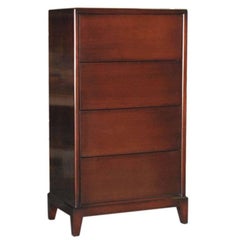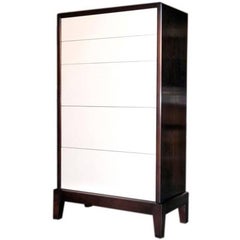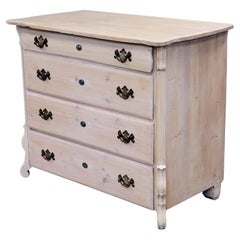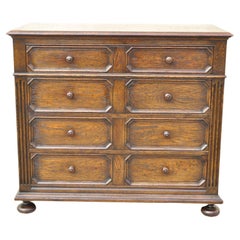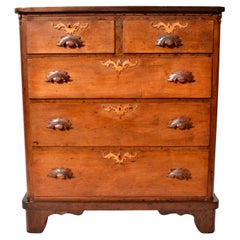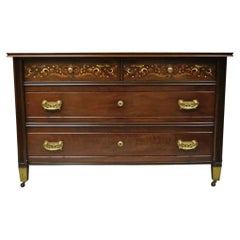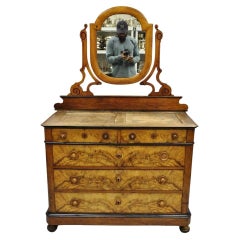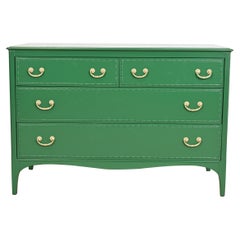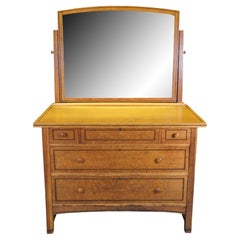Antique Dressers Chests
21st Century and Contemporary American Minimalist Commodes and Chests of...
Walnut
2010s American Commodes and Chests of Drawers
Walnut
Early 20th Century Dutch Dutch Colonial Dressers
Brass
Early 20th Century Jacobean Dressers
Oak
Antique Late 19th Century American American Classical Dressers
Cherry, Pine
Antique Late 19th Century Unknown Edwardian Dressers
Brass
Antique Late 19th Century Unknown Empire Dressers
Mirror, Walnut
Vintage 1920s American Louis XVI Dressers
Brass
Antique Late 19th Century Victorian Dressers
Mirror, Oak
Antique Mid-19th Century German Biedermeier Dressers
Cherry
Antique 1890s Japanese Baroque Dressers
Iron
Antique Mid-19th Century American Empire Dressers
Mahogany
Antique 1880s Eastlake Dressers
Cherry
Vintage 1930s American Art Deco Dressers
Wood
Antique 1890s Japanese Dressers
Iron
Vintage 1980s Japanese Dressers
Iron
Antique 19th Century North American Federal Dressers
Mahogany
Antique Late 19th Century Dressers
Granite, Brass
Antique 1880s Victorian Dressers
Marble
Early 20th Century Danish Country Dressers
Mirror, Pine
Antique Early 19th Century Empire Dressers
Mahogany
Vintage 1970s Mid-Century Modern Dressers
Mahogany
Antique 19th Century English Queen Anne Dressers
Brass
Vintage 1920s Louis XVI Dressers
Marble
2010s Italian Post-Modern Commodes and Chests of Drawers
Brass
2010s Italian Post-Modern Commodes and Chests of Drawers
Brass
2010s Italian Post-Modern Commodes and Chests of Drawers
Brass
2010s Italian Post-Modern Commodes and Chests of Drawers
Brass
Early 20th Century Japanese Taisho Commodes and Chests of Drawers
Brass
Antique 19th Century French Dutch Colonial Dressers
Wood
Antique 1760s English George III Dressers
Mahogany
Antique Late 19th Century English Commodes and Chests of Drawers
Mahogany
Vintage 1920s American American Classical Dressers
Wood
20th Century American Mid-Century Modern Dressers
Mahogany
Vintage 1950s Dressers
Marble
Antique 19th Century American Mid-Century Modern Commodes and Chests of ...
Brass
Antique Late 19th Century Japanese Dressers
Pine, Fir
Antique Late 18th Century American Chippendale Dressers
Cherry
Antique Early 19th Century French Empire Dressers
Birch
Antique 19th Century Dressers
Wood
Antique Late 19th Century French Louis XV Dressers
Rosewood
Antique Late 19th Century Italian Dressers
Walnut
Antique 19th Century Spanish Empire Commodes and Chests of Drawers
Marble
Antique Mid-18th Century French Baroque Dressers
Brass
Antique Late 19th Century French Baroque Revival Dressers
Marble, Brass
Antique 19th Century American American Empire Dressers
Mahogany
Antique 18th Century Italian Louis XV Dressers
Walnut
Antique Early 1900s German Art Nouveau Commodes and Chests of Drawers
Brass
Antique Early 1900s Italian Country Dressers
Walnut
Antique Late 18th Century French Dressers
Fruitwood, Nutwood
Antique 19th Century American Chippendale Commodes and Chests of Drawers
Maple
Antique Late 19th Century Italian Dressers
Poplar
21st Century and Contemporary American Art Deco Dressers
Brass
Antique Late 19th Century American Victorian Commodes and Chests of Drawers
Brass
Early 20th Century Unknown Chippendale Commodes and Chests of Drawers
Mahogany
Antique 1820s American Federal Dressers
Mahogany
Antique Late 19th Century British Edwardian Commodes and Chests of Drawers
Brass
Antique 19th Century American Victorian Dressers
Mirror, Oak
21st Century and Contemporary Italian Modern Dressers
Brass
2010s Indian Art Deco Dressers
Metal, Sheet Metal
- 1
- ...
Antique Dressers Chests For Sale on 1stDibs
How Much are Antique Dressers Chests?
Finding the Right Case Pieces And Storage Cabinets for You
Of all the vintage storage cabinets and antique case pieces that have become popular in modern interiors over the years, dressers, credenzas and cabinets have long been home staples, perfect for routine storage or protection of personal items.
In the mid-19th century, cabinetmakers would mimic styles originating in the Louis XIV, Louis XV and Louis XVI eras for their dressers, bookshelves and other structures, and, later, simpler, streamlined wood designs allowed these “case pieces” or “case goods” — any furnishing that is unupholstered and has some semblance of a storage component — to blend into the background of any interior.
Mid-century modern furniture enthusiasts will cite the tall modular wall units crafted in teak and other sought-after woods of the era by the likes of George Nelson, Poul Cadovius and Finn Juhl. For these highly customizable furnishings, designers of the day delivered an alternative to big, heavy bookcases by considering the use of space — and, in particular, walls — in new and innovative ways. Mid-century modern credenzas, which, long and low, evolved from tables that were built as early as the 14th century in Italy, typically have no legs or very short legs and have grown in popularity as an alluring storage option over time.
Although the name immediately invokes images of clothing, dressers were initially created in Europe for a much different purpose. This furnishing was initially a flat-surfaced, low-profile side table equipped with a few drawers — a common fixture used to dress and prepare meats in English kitchens throughout the Tudor period. The drawers served as perfect utensil storage. It wasn’t until the design made its way to North America that it became enlarged and equipped with enough space to hold clothing and cosmetics. The very history of case pieces is a testament to their versatility and well-earned place in any room.
In the spirit of positioning your case goods center stage, decluttering can now be design-minded.
A contemporary case piece with open shelving and painted wood details can prove functional as a storage unit as easily as it can a room divider. Alternatively, apothecary cabinets are charming case goods similar in size to early dressers or commodes but with uniquely sized shelving and (often numerous) drawers.
Whether you’re seeking a playful sideboard that features colored glass and metal details, an antique Italian hand-carved storage cabinet or a glass-door vitrine to store and show off your collectibles, there are options for you on 1stDibs.
- What is a chest dresser called?1 Answer1stDibs ExpertAugust 20, 2024What a chest dresser is called varies. Some people refer to this type of storage furniture as a bureau or chest of drawers. It's also correct to simply call one a dresser or a chest. Shop a large selection of dressers from some of the world's top sellers on 1stDibs.
- 1stDibs ExpertApril 1, 2024The difference between a chest and a dresser is that dressers are short, and chests of drawers are overall taller pieces of furniture that typically do not have room on the top for a mirror as most dressers do.
The first step in finding the perfect dresser is considering your particular needs. Most tall dressers offer anywhere from five to seven drawers, essentially allowing for the organization of an entire wardrobe, while shorter, waist-height dresser varieties can be equipped with a convenient vanity mirror.
Find antique and vintage dressers for sale on 1stDibs. - 1stDibs ExpertApril 1, 2024Yes, there is a difference between a dresser and a chest of drawers. Dressers are short, and chests of drawers are overall taller pieces of furniture that typically do not have room on the top for a mirror as most dressers do.
Although the name immediately invokes images of clothing, dressers were initially created in Europe for a much different purpose. This type of case piece was originally a flat-surfaced, low-profile side table equipped with a few drawers — a common fixture used to dress and prepare meats in English kitchens throughout the Tudor period.
Find antique and vintage dressers for sale on 1stDibs. - 1stDibs ExpertNovember 2, 2021Dressers are designed to offer a place for you to dress, with the top functioning as a table on which to place your clothing. It will offer space for a mirror, whereas chests of drawers are typically exactly that — they provide ample storage while taking up little floor space. A dresser is usually wide and short, while a chest of drawers is narrow and tall. Both types of furniture are commonly used to store clothing and other items in drawers. Shop a collection of antique, vintage, and contemporary dressers and chests of drawers from some of the world’s top dealers on 1stDibs.
- 1stDibs ExpertSeptember 23, 2024To identify an antique dresser, examine it for markings that indicate who produced it. Makers typically add brands, carvings, paper labels or metal tags to inconspicuous areas, such as the inside of a drawer or the back of a dresser. If you can locate a marking, you can use trusted online resources to figure out who made it and learn more about your dresser. Unfortunately, some antique pieces may be unmarked or have lost their tags or labels over the years. With these pieces, you can turn to a certified appraiser or experienced antiques dealer for assistance with the identification process. Find a wide variety of antique dressers on 1stDibs.
- 1stDibs ExpertAugust 26, 2024The difference between a bureau, a chest of drawers and a dresser comes down to shape and function. Dressers and chests of drawers are both types of bedroom furniture that feature storage drawers. However, bureaus tend to be wider and shorter, while chests of drawers are narrower and taller. Often used for storage outside of bedrooms, bureaus are usually about the same height as dressers but are shorter than chests of drawers. Find a wide range of casegoods on 1stDibs.
- 1stDibs ExpertOctober 7, 2024The difference between a dresser, a bureau and a chest of drawers is where you place these furnishings and their overall shapes and designs. Usually positioned in a bedroom, a dresser is a wide, low casegood consisting of two or more columns of drawers. When this type of furniture is placed in a living room, office, library or other space beyond the bedroom, people normally refer to it as a bureau. Another type of bedroom furnishing is a chest of drawers, which is a tall vertical column of drawers stacked one above the other. On 1stDibs, shop a diverse assortment of dressers, bureaus and chests of drawers.
- 1stDibs ExpertSeptember 9, 2024To tell if a chest is antique, first examine its materials and details carefully. An antique chest is one produced 100 years ago or more. This generally predates the use of engineered wood, particleboard, plastics and other synthetic materials. As a result, an antique chest usually features solid wood construction.
In addition, antique chests are likely to be handmade, so you should be able to spot subtle signs that indicate this, such as tool marks and small irregularities in any carvings. If a piece looks flawless and regular, it is unlikely to be antique. Locating a maker's mark and then researching when the manufacturer was active can also help you date your chest. Alternatively, you can use the services of a certified appraiser or knowledgeable antique dealer to learn more about your chest.
On 1stDibs, shop a large selection of antique chests. - 1stDibs ExpertNovember 4, 2024To identify an antique chest of drawers, look inside and beneath drawers and on the back and bottom for any type of maker's marking. Researching these marks using trusted online resources may allow you to determine who produced your chest and roughly date your piece. If your chest is at least 100 years old, it is an antique. Should you be unable to locate the maker's marks, look at the hardware. Rose head nails, one-piece cast brass pommels on the drawer handles and circular rather than hexagonal bolts may all indicate that a piece is an antique. Keep in mind that hardware may have been replaced at some point and that there are many reproductions of antique furnishings. As a result, you may wish to have a certified appraiser or experienced antique dealer complete the identification process if you're unable to identify your chest via the maker's markings. Find a range of antique chests of drawers on 1stDibs.
Read More
The Ultimate Guide to Types of Tables for the Home
Whether you’re just moving in or ready to give your home a makeover, our guide will give you pointers on tables that are fitting for every room, nook and hallway.
What Exactly Is a Secretary Desk, and What Is It Used For?
The furniture equivalent of a Swiss Army knife, it's the multifunctional piece you didn't know you needed.
This Shelving System with Oxidized Brass Tubes Is Retro and Futuristic at Once
Italian studio DimoreMilano mustered great ingenuity when crafting these sculptural shelves, which are built without any screws.
28 Cheerful Home Bars, Where Everybody (Literally) Knows Your Name
Simple or sophisticated, equipped with console, cart or custom cabinetry, these stylish bar areas deserve a toast.
Ask an Interior Designer: Work-from-Home Edition
Leaping into a design project, whether it's refreshing the bedroom or redoing the whole house, can be overwhelming. Luckily, we know more than a few interior designers. You asked questions on Instagram, and now they're answering.
Collected and Eclectic, ‘Wunderkammern’ Are Back in a Big Way
Introduced nearly 500 years ago, curiosity cabinets are finding new fans among today's collectors and designers.
Meet the Incredible Woman Transforming Fallen Trees into Sleek Furniture
In the hands of New York Heartwoods cofounder Megan Offner, unwanted local trees become works of design art.
These New York Architects Love a Complicated Project
From Brooklyn townhouses to Maine campgrounds, Trattie Davies and Jonathan Toews relish a challenge, like transforming a former warehouse space into the new 1stdibs Gallery.
